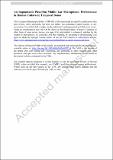| dc.contributor.author | Zhang, John Z. | |
| dc.contributor.author | Graf, Lukas | |
| dc.contributor.author | Banerjee, Annesya | |
| dc.contributor.author | Yeiser, Aaron | |
| dc.contributor.author | McHugh, Christopher I. | |
| dc.contributor.author | Kymissis, Ioannis | |
| dc.contributor.author | Lang, Jeffrey H. | |
| dc.contributor.author | Olson, Elizabeth S. | |
| dc.contributor.author | Nakajima, Hideko H. | |
| dc.date.accessioned | 2025-06-16T17:05:36Z | |
| dc.date.available | 2025-06-16T17:05:36Z | |
| dc.date.issued | 2024-01-18 | |
| dc.identifier.uri | https://hdl.handle.net/1721.1/159418 | |
| dc.description.abstract | Purpose One of the major reasons that totally implantable cochlear microphones are not readily available is the lack of good implantable microphones. An implantable microphone has the potential to provide a range of benefits over external microphones for cochlear implant users including the filtering ability of the outer ear, cosmetics, and usability in all situations. This paper presents results from experiments in human cadaveric ears of a piezofilm microphone concept under development as a possible component of a future implantable microphone system for use with cochlear implants. This microphone is referred to here as a drum microphone (DrumMic) that senses the robust and predictable motion of the umbo, the tip of the malleus. Methods The performance was measured by five DrumMics inserted in four different human cadaveric temporal bones. Sensitivity, linearity, bandwidth, and equivalent input noise were measured during these experiments using a sound stimulus and measurement setup. Results The sensitivity of the DrumMics was found to be tightly clustered across different microphones and ears despite differences in umbo and middle ear anatomy. The DrumMics were shown to behave linearly across a large dynamic range (46 dB SPL to 100 dB SPL) across a wide bandwidth (100 Hz to 8 kHz). The equivalent input noise (over a bandwidth of 0.1–10 kHz) of the DrumMic and amplifier referenced to the ear canal was measured to be about 54 dB SPL in the temporal bone experiment and estimated to be 46 dB SPL after accounting for the pressure gain of the outer ear. Conclusion The results demonstrate that the DrumMic behaves robustly across ears and fabrication. The equivalent input noise performance (related to the lowest level of sound measurable) was shown to approach that of commercial hearing aid microphones. To advance this demonstration of the DrumMic concept to a future prototype implantable in humans, work on encapsulation, biocompatibility, and connectorization will be required. | en_US |
| dc.publisher | Springer US | en_US |
| dc.relation.isversionof | https://doi.org/10.1007/s10162-024-00927-4 | en_US |
| dc.rights | Creative Commons Attribution-Noncommercial-ShareAlike | en_US |
| dc.rights.uri | http://creativecommons.org/licenses/by-nc-sa/4.0/ | |
| dc.source | Springer US | en_US |
| dc.title | An Implantable Piezofilm Middle Ear Microphone: Performance in Human Cadaveric Temporal Bones | en_US |
| dc.type | Article | en_US |
| dc.identifier.citation | Zhang, J.Z., Graf, L., Banerjee, A. et al. An Implantable Piezofilm Middle Ear Microphone: Performance in Human Cadaveric Temporal Bones. JARO 25, 53–61 (2024). | en_US |
| dc.contributor.department | Massachusetts Institute of Technology. Department of Mechanical Engineering | en_US |
| dc.contributor.department | Massachusetts Institute of Technology. Department of Electrical Engineering and Computer Science | en_US |
| dc.relation.journal | Journal of the Association for Research in Otolaryngology | en_US |
| dc.eprint.version | Author's final manuscript | en_US |
| dc.type.uri | http://purl.org/eprint/type/JournalArticle | en_US |
| eprint.status | http://purl.org/eprint/status/PeerReviewed | en_US |
| dc.date.updated | 2025-03-27T13:47:37Z | |
| dc.language.rfc3066 | en | |
| dc.rights.holder | The Author(s) under exclusive licence to Association for Research in Otolaryngology | |
| dspace.embargo.terms | Y | |
| dspace.date.submission | 2025-03-27T13:47:37Z | |
| mit.journal.volume | 25 | en_US |
| mit.license | PUBLISHER_POLICY | |
| mit.license | OPEN_ACCESS_POLICY | |
| mit.metadata.status | Authority Work and Publication Information Needed | en_US |
